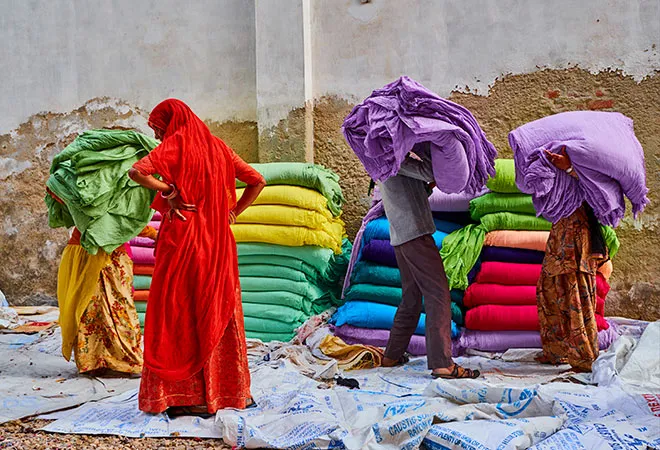-
CENTRES
Progammes & Centres
Location
Urban planners will have to imagine novel ways of ordering and expressing their spaces to eliminate the unequal power dynamics in urbanisation

With increasing pressure to accommodate ever-evolving citizens’ needs, more so in a post-pandemic setting, city planners are reimagining their approaches and priorities. However, such changes are challenging for cities in the developing world, where providing for basic needs assumes precedence over enhancing quality of life and citizen safety. Gender balance in the built environment often gets disregarded in historically patriarchal societies.
City planning has generally been criticised for failing women because they typically do not fulfil the different needs of women and marginalised genders due to conventional mindsets, social norms, and exclusion. City planning often overlooks the rather complex movements of women within the city, as compared to men, including their vulnerability to sexual harassment and gender-based violence.
Less than 50 percent of the indicators available to monitor the Sustainable Development Goals take into account the gender perspective.
Women, girls, and gender minorities make up half the urban population. Women experience and perceive the city differently than men. Despite this, less than 50 percent of the indicators available to monitor the Sustainable Development Goals take into account the gender perspective. Data gaps and a lack of comparable methodologies make it difficult to study qualitative metrics that play a role in decision-making. Without a meaningful effort to determine these metrics, gender-balanced planning approaches become problematic, calling for a relook at urban planning approaches to ensure the representation of women and minority gender voices and to amplify gender interests.
Cisgender approaches
Conventional frameworks applied to urban planning tend to discriminate across all aspects of the planning spectrum. Cities become discriminatory through their expression and reinforcement of gender biases based on social conditioning and cultural or linguistic expressions. Flouting preconceived social norms is often considered offensive and involves socio-legal implications. For instance, a cisgender understanding results in different seating areas for men and women in public places with monetary penalties and social rebuke for those who breach this rule. Such cisgender approaches impede the representation and participation of women in urban public life and make women feel threatened in public places. They also express their preference for gender-neutral spaces.
Viewed within this frame, reserving whole compartments in trains, dedicated seating areas in buses, women-driven taxis, or women-only washrooms are not solutions but problems stemming from a patriarchal mindset. They call for a fundamental shift in thinking and behaviour—a whole societal approach—to make gender sensitivity integral to public life and manifest expression.
Unequal representation
Less than 10 percent of architects and urban planners being women has also contributed to a biased representation of gender needs and has reinforced lopsided perspectives and attitudes towards gender-based privileges for accessing the city. For instance, low-lit public parks and public restrooms emanate from cisgender approaches, showing the lack of understanding of women and minority gender needs. The needs of trans people remain mostly ignored.
Reserving whole compartments in trains, dedicated seating areas in buses, women-driven taxis, or women-only washrooms are not solutions but problems stemming from a patriarchal mindset.
Multiple surveys have shown women feeling that cities are unsafe and perilous. Urban infrastructure disregards women’s needs rendering them invisible in the city, far from participating in shaping it for equal access. For instance, a 2021 study in Bengaluru revealed that 50 percent of women suffered from mental stress due to the lack of public toilets. Such statistics illustrate how uneven access to public amenities, gendered zoning, and poor lighting play a significant role in the detrimental participation of gender minorities.
Administrative lethargy
Laudable ideas must overcome administrative lethargy and labyrinthine bureaucracy to manifest beyond the planning stage, a particular problem in India. For instance, one is yet to see meaningful action on Mumbai’s Draft DP2034 on ‘Gender, Special Groups and Social Equity’ and the Gender Advisory Committee. These proposals aimed to achieve gender parity in the workforce, housing, transport, and education, and recommended measures for improving the healthcare for and the safety of women and marginalised genders. Likewise, the 2011 Draft Strategic Framework for Women’s Safety in Delhi has remained only on paper. This is a pattern that mars the urban planning process across the country.
The Fourth United Nations World Conference on Women declared gender mainstreaming essential to sustainable human development. Yet, there are hardly any global agreements for gender inclusion. However, reference frameworks such as the Handbook for Gender-Inclusive Urban Planning and Design, outlining how cities can be planned for everyone through simple design measures, and the UN Habitat’s Gender Issue Guide, offering gender mainstreaming strategies for urban planning, are good starting points. Yet, they would amount to little if they do not factor in lived experiences and aspirations. Urban planning and design regulations and policies need to set out practical approaches for implementing a participatory design process by exploring the city’s lived experiences from the perspective of vulnerable groups.
Regulations for ample street lighting, wide pavements for buggies, additional seating, mirrors for safety in shortcuts and alleyways, and gender-sensitive design of public parks to prevent anxiety-inducing spaces are central to making the environment safe and attractive for women and marginalised genders.
Successful global models incorporating gender into their urban planning process offer valuable insights. Zurich, which topped the 2019 PICSA Index, has set up a separate Office for Gender Equality, which filters planning decisions through the gender lens and works towards making the city welcoming for all genders and making gender responsiveness vital to its urban function. The city provides safe meeting spaces for LGBTQ+ persons, such as the Regenbogenhaus (Rainbow House), to discuss topics and address concerns of lesbian, gay, bi, trans, and queer citizens in Zurich, but it also welcomes all to participate as part of its whole-of-society approach to urban planning.
Vienna provides an important gender mainstreaming template for equal representation with more than 60 citywide initiatives and a Women’s Unit within the Directorate for Urban Planning. Regulations for ample street lighting, wide pavements for buggies, additional seating, mirrors for safety in shortcuts and alleyways, and gender-sensitive design of public parks to prevent anxiety-inducing spaces are central to making the environment safe and attractive for women and marginalised genders. Vienna’s Frauen-Werk-Stadt (Women-Work-City) promotes subsidised housing facilities designed for and by women. Some cities, such as Umeå in Sweden, further incorporate the needs of specific sub-groups. For instance, the Årstidernas park was designed with insights from teenage girls, whose needs are otherwise overlooked, to make them feel comfortable and safe.
A few cities in India, too, are making efforts for gender-balanced planning. The Thiruvananthapuram municipality is developing multiple women-friendly areas in its cultural district in partnership with women citizens and planners. These would, among other things, include a 24/7 pink police, breastfeeding kiosks, She toilets, and She autos. Similarly, Hyderabad launched its first-ever theme park exclusively for women and children under the age of 10. A few cities have begun hosting annual gatherings for LGBTQ+ persons, with Delhi opening its first gay-only hotel. The Municipal Corporation of Delhi is also planning to build 500 toilets for the LGBTQ+ community.
Using a gender lens, planners should regularly encourage discussions for auditing and amending existing municipal laws.
However flawed or limited, these initiatives are laudable as they signify intent within a largely gender-deaf ecosystem and could serve as the springboard towards gender-sensitive and gender-balanced cities of the future.
Urban planners will have to imagine novel ways of ordering and expressing their spaces to eliminate the unequal power dynamics in urbanisation. Cities that do not bear gender sensitivities are failing their women and marginalised genders and risking implosion.
It is imperative and only fair that as 50 percent of the urban population, women and gender minorities play a fundamental role in city planning and administration. Co-creating and redefining the built environment remains the only way forward for building sustainable cities of the future.
The views expressed above belong to the author(s). ORF research and analyses now available on Telegram! Click here to access our curated content — blogs, longforms and interviews.

Anusha is Senior Fellow at ORF’s Centre for Economy and Growth. Her research interests span areas of Urban Transformation, Spaces and Habitats. Her work is centred ...
Read More +